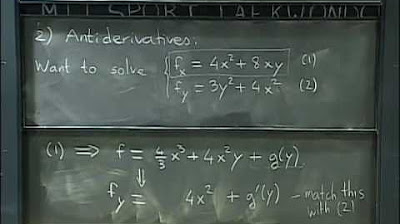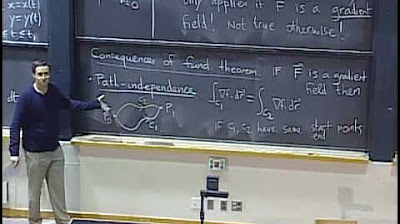Conservative Vector Fields & Potential Functions
TLDRThis Houston Math Prep video tutorial introduces shortcuts for calculating line integrals by identifying gradient fields. It explains that a vector field is a gradient field if its components are the partial derivatives of a scalar function, known as the potential function. The tutorial demonstrates how to verify if a vector field is a gradient field by comparing mixed partial derivatives and provides step-by-step examples of finding potential functions for both 2D and 3D gradient fields. The importance of gradient fields in simplifying line integrals and the concept of conservativeness are highlighted, with the promise of further exploration in upcoming videos.
Takeaways
- 📚 The script introduces shortcuts for line integrals, particularly for gradient fields, to avoid the need for parameterizing curves and the full integration process every time.
- 🔍 The gradient of a scalar function \( \nabla f \) is defined by the partial derivatives with respect to x and y, and a vector field is considered a gradient field if its components satisfy certain conditions related to these derivatives.
- 🧭 A gradient field is identified by checking if the partial derivative of the M component with respect to Y equals the partial derivative of the N component with respect to X, and this must hold true for the field to be considered a gradient field.
- 📉 In physics, the potential is considered to have the opposite sign of what is calculated in mathematics, but the concept is fundamentally the same.
- 🔑 To determine if a vector field is a gradient field, one must ensure the mixed partial second derivatives \( f_{xy} \) and \( f_{yx} \) are equal, assuming the functions are well-behaved, continuous, and the region is simply connected.
- 🚫 The script provides an example where a vector field is not a gradient field because the partial derivatives do not match, demonstrating the process of elimination based on this criterion.
- ✅ Another example shows a vector field that is a gradient field, with matching partial derivatives, and the script explains how to find its potential function by integrating the components with respect to the correct variables.
- 🔄 The process of finding a potential function involves integrating the components of the gradient field vector and combining unique terms to form the scalar potential function.
- 📐 For a vector field in 3D space to be a gradient field, additional conditions involving the partial derivatives with respect to the third variable (Z) must be satisfied.
- 📝 The script walks through examples in 3D space, showing how to check for gradient fields and find potential functions, emphasizing the importance of matching partial derivatives in all required combinations.
- 🔍📚 The final takeaway is an anticipation of the next video, which will explore the concept of conservativeness and path independence in gradient fields, providing further insights into the significance of these fields in mathematics.
Q & A
What is a gradient field in the context of vector calculus?
-A gradient field is a vector field where each component of the vector field is the partial derivative of a scalar function with respect to the corresponding variable. For a two-dimensional vector field with components M and N, this means M = ∂F/∂x and N = ∂F/∂y for some scalar function F(x, y).
What is the significance of the potential function in a gradient field?
-The potential function in a gradient field is the scalar function from which the vector field is derived. It is called 'potential' because it represents the work done by the gradient field in moving a unit mass from a reference point to a point in the field, and it is essential for simplifying line integrals in conservative vector fields.
How can you determine if a given vector field is a gradient field?
-To determine if a vector field is a gradient field, you must check if the mixed partial derivatives of the scalar function are equal, i.e., ∂M/∂y = ∂N/∂x. This must hold true for the vector field to be considered a gradient field.
What is the difference between potential in physics and the potential function in mathematics?
-In physics, potential is often considered with the opposite sign compared to how it is calculated in mathematics. However, the underlying concept is the same, representing the work done against a field.
How do you find the potential function of a gradient field?
-To find the potential function of a gradient field, you integrate the components of the vector field with respect to the corresponding variables. For a two-dimensional field, integrate M with respect to x and N with respect to y, and combine the unique terms obtained from these integrations.
What is the condition for a vector field in three-dimensional space to be a gradient field?
-In three-dimensional space, for a vector field to be a gradient field, the mixed partial derivatives must satisfy the following conditions: ∂M/∂y = ∂N/∂x, ∂N/∂z = ∂P/∂y, and ∂M/∂z = ∂P/∂x, where M, N, and P are the components of the vector field.
Why is it important to check the equality of mixed partial derivatives when determining if a vector field is a gradient field?
-Checking the equality of mixed partial derivatives ensures that the vector field components can be derived from a single scalar potential function, which is a characteristic of gradient fields. This equality is a necessary condition for the existence of a potential function.
What is the process of finding a potential function for a given gradient field?
-The process involves integrating each component of the gradient field with respect to its corresponding variable. After integration, you combine all unique terms from the results to form the potential function.
Can every vector field be a gradient field?
-No, not every vector field can be a gradient field. A vector field can only be a gradient field if it satisfies the condition of having equal mixed partial derivatives and if it can be derived from a scalar potential function.
What is the significance of finding a potential function in the context of line integrals?
-Finding a potential function for a gradient field allows for simplification of line integrals, as the integral of a gradient field along any path between two points is independent of the path taken, a property known as path independence, which is crucial in conservative fields.
How does the concept of a gradient field relate to the idea of conservative vector fields?
-A gradient field is a type of conservative vector field. Conservative fields have the property that the work done by the field on a particle moving between two points is independent of the path taken, which is a direct consequence of the existence of a potential function.
Outlines
📚 Introduction to Gradient Fields and Line Integral Shortcuts
This paragraph introduces the concept of gradient fields and line integral shortcuts in the context of vector calculus. It explains the gradient of a scalar function as the partial derivatives with respect to x and y, and how a vector field can be identified as a gradient field if its components are the partial derivatives of a potential function. The paragraph also touches on the importance of mixed partial derivatives being equal for well-behaved functions and the concept of potential in physics versus mathematics. The speaker provides a method to check if a vector field is a gradient field by comparing the partial derivatives of its components.
🔍 Identifying Gradient Fields and Finding Potential Functions
The speaker delves deeper into identifying gradient fields by comparing partial derivatives of the field's components. Two examples are provided to illustrate the process: one where the vector field is not a gradient field due to non-matching partial derivatives, and another where it is confirmed as a gradient field with matching derivatives. The paragraph then explains how to find the potential function of a gradient field by integrating the components with respect to the appropriate variables, emphasizing the importance of combining unique terms to form the potential function.
📘 Expanding Gradient Field Concepts to Three Dimensions
This section extends the discussion of gradient fields to three-dimensional space, explaining the additional conditions required for a vector field to be a gradient field in 3D. The speaker outlines the necessary partial derivatives that must be equal and provides examples to demonstrate how to verify if a given vector field in 3D is a gradient field. The examples include checking the equality of mixed partial derivatives for the components of the vector field in three dimensions.
🔑 Utilizing Gradient Fields for Conservative Vector Fields and Path Independence
The final paragraph wraps up the discussion by emphasizing the utility of gradient fields in determining conservative vector fields and path independence. The speaker hints at the significance of gradient fields in simplifying line integrals and mentions that the next video will explore the concepts of conservativeness and path independence in more detail. The paragraph concludes with a teaser for the upcoming video and a thank you note to the viewers.
Mindmap
Keywords
💡Line Integrals
💡Scalar Function
💡Gradient
💡Vector Field
💡Potential Function
💡Mixed Partial Derivatives
💡Simply Connected Region
💡Conservative Vector Field
💡Antiderivatives
💡3D Space
Highlights
Introduction to shortcuts for line integrals to simplify the process without parameterizing curves each time.
Explanation of the gradient for a scalar function as the partial derivatives with respect to x and y.
Definition of a vector field as a gradient field if its components are the partial derivatives of a scalar function.
Note on the difference in sign convention between physics and mathematics for potential functions.
Criteria for a vector field to be a gradient field: equal mixed partial second derivatives and continuity in a simply connected region.
Method to check if a vector field is a gradient field by comparing partial derivatives of its components.
Example analysis of the vector field XE^(XY), YE^(XY) to determine if it is a gradient field.
Conclusion that the vector field XE^(XY), YE^(XY) is not a gradient field based on unequal partial derivatives.
Analysis of the vector field 3x^2 + 3y^2, 6xy to determine if it is a gradient field.
Confirmation that the vector field 3x^2 + 3y^2, 6xy is a gradient field with equal partial derivatives.
Process to find the potential function of a gradient field by integrating its components with respect to the correct variables.
Example of finding the potential function for the gradient field 3x^2 + 3y^2, 6xy.
Importance of including only unique terms when combining potential functions from antiderivatives.
Example analysis of the vector field Ycos(X) - 2Xcos(Y), sin(X) + X^2sin(Y) to determine if it is a gradient field.
Confirmation that the vector field Ycos(X) - 2Xcos(Y), sin(X) + X^2sin(Y) is a gradient field with matching partial derivatives.
Finding the potential function for the gradient field Ycos(X) - 2Xcos(Y), sin(X) + X^2sin(Y) by integrating its components.
Criteria for a vector field in 3D space to be a gradient field, including the need for matching mixed partial derivatives.
Example analysis of a 3D vector field to determine if it is a gradient field by checking the equality of mixed partial derivatives.
Process to find the potential function of a 3D gradient field by integrating its components with respect to the proper variables.
Conclusion on the method to determine if a vector field is a gradient field and how to find its potential function, with a preview of the next video on conservativeness and path independence.
Transcripts
Browse More Related Video

Lec 21: Gradient fields and potential functions | MIT 18.02 Multivariable Calculus, Fall 2007

Conservative Fields & Path Independence (Vector Fields)

Path independence for line integrals | Multivariable Calculus | Khan Academy

Lec 20: Path independence and conservative fields | MIT 18.02 Multivariable Calculus, Fall 2007

Example of closed line integral of conservative field | Multivariable Calculus | Khan Academy

Line Integrals of Vector Fields (Introduction)
5.0 / 5 (0 votes)
Thanks for rating: